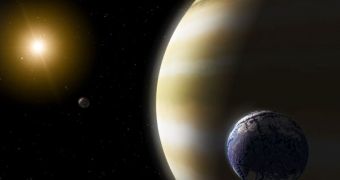According to some scientists, the Universe could be riddled with ten thousand billion Earth-like, habitable planets, which could have the potential to support life, or at least even harbor liquid water. All of them could be discovered with the aid of NASA's new Kepler Space Telescope (KST), Carnegie Institution in Washington astrophysicist Alan Boss claims in his new book, “The Crowded Universe.” He bases his number not on wild guess, but on a scientific line of reasoning that has thus far worked.
At the root of this astronomical number of habitable planets possibly existing in the Universe lies a very simple estimate. Boss says that he assumes the existence of such a celestial body around every Sun-like star in the galaxy. Seeing how there are approximately 10 billion such celestial bodies in each similar aggregate of stars, he holds this to be the general rule in all galaxies. So, when this figure is multiplied by 100 billion, the estimated number of star systems that wonder around in the Universe, even the most un-skilled mathematician gets the same results.
“Based on what we already know, the universe is going to turn out to be [a] chock full of habitable planets (i.e. Earth-like worlds), and therefore life is likely to be widespread,” he told reporters last week in Chicago, at the annual meeting of the American Association for the Advancement of Science (AAAS).
“We already know from folks who have been finding planets around other stars that most stars have planets. Simply from a theoretical ground of understanding how stars form, it's almost inevitable that they should end up having disks around them, which should end up forming planets. So we expect them to be there from the point of view of theory as well,” the scientist added.
Over the past few years, more than 300 exoplanets have been found, but astronomers have always said that the current technology employed by observatories, both on Earth and in orbit, is simply insufficient to allow them to detect Earth-sized planets orbiting remote and distant stars. However, scientists at the Geneva Observatory, led by Stephane Udry, managed to discover two cool planets in 2007, which could potentially sustain life or water, circling the Gliese 581 star.
“There are something like a few dozen solar-type stars within 30 light years of the sun. I would think a good number of those, perhaps half of them, will have Earth-like planets. So I think there are very good chances that we'll find some Earth-like planets within 10, 20, 30 light years of the sun,” he concluded.

 14 DAY TRIAL //
14 DAY TRIAL //